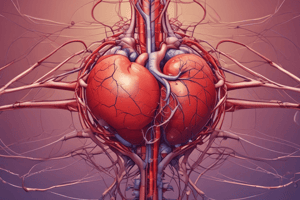Podcast
Questions and Answers
What percentage of the body mass is blood?
What percentage of the body mass is blood?
- 7% (correct)
- 15%
- 10%
- 5%
What is the function of red blood cells?
What is the function of red blood cells?
- Carrying oxygen from the lungs to the cells (correct)
- Regulating body temperature
- Blood clotting
- Fighting infection
What is the percentage of blood in systemic circulation that is in veins?
What is the percentage of blood in systemic circulation that is in veins?
- 85%
- 75% (correct)
- 65%
- 50%
What is the main component of plasma?
What is the main component of plasma?
What is the function of platelets?
What is the function of platelets?
What is one of the ways blood regulates body temperature?
What is one of the ways blood regulates body temperature?
What is the function of the valves in the heart?
What is the function of the valves in the heart?
At what point does the fetal heart start pumping blood to the tissues?
At what point does the fetal heart start pumping blood to the tissues?
What is the term for the condition where the infant's blood is not properly oxygenated due to an unclosed opening in the heart?
What is the term for the condition where the infant's blood is not properly oxygenated due to an unclosed opening in the heart?
What is an example of a heart valve defect?
What is an example of a heart valve defect?
Flashcards are hidden until you start studying
Study Notes
Cardiovascular System (CVS)
- The CVS has three main functions: supplying energy (fuel) from food, supplying oxygen from the air we breathe, and disposing of by-products of combustion (CO2, H2O, and heat).
- The major components of the CVS are blood, heart, and vessels.
Blood
- Blood circulation comprises 7% of the body mass.
- Systemic circulation accounts for 80% of blood circulation, divided into:
- Arteries: 15%
- Capillaries: 10%
- Veins: 75%
- Pulmonary circulation accounts for 20% of blood circulation, divided into:
- Arteries: 46.5%
- Veins: 46.5%
- Capillaries: 7%
- Blood composition:
- Plasma: 55-60% of blood volume, mostly water, containing nutrients, electrolytes, hormones, and protein antibodies.
- Cells:
- Red blood cells (erythrocytes): carry oxygen, disk-shaped, and give blood its red color.
- White blood cells (leukocytes): important for the immune system, spherical-shaped.
- Platelets (thrombocytes): important for blood clotting, flat-shaped.
Blood Functions
- Distribution:
- Supplies oxygen from the lungs to cells.
- Supplies nutrients from the digestive system to cells.
- Transports metabolic wastes from cells to disposal sites.
- Transports hormones to target tissues/organs.
- Regulation:
- Regulates body temperature.
- Regulates pH of body fluids.
- Regulates blood volume to support efficient circulation.
- Protection:
- Prevents blood loss by activating plasma proteins and platelets, and initiating clot formation.
- Prevents infection by synthesizing and utilizing antibodies, and activating WBCs to defend the body.
Heart
- The heart is a double pump, providing the force needed to circulate blood through the pulmonary and systemic circulatory systems.
- The heart has a system of valves that permit blood to flow only in the correct direction.
- Fetal heart development:
- After 8 weeks of conception, the fetus' heart starts working, pumping blood to tissues.
- The fetal heart has an opening that permits blood to flow from the right atrium to the left one, which must close within minutes after birth.
- Heart chamber pressures:
- Right atrium: 5-6mmHg.
- Right ventricle: 25mmHg.
- Left atrium: 7-8mmHg.
- Left ventricle: 120mmHg (systolic pressure), 80mmHg (diastolic pressure).
Physics of Heart Diseases
- Blood pressure diseases: high blood pressure (hypertension) or low blood pressure (hypotension).
- Fast heart rate (tachycardia): increases the workload and the amount of time the heart muscles spend contracting.
- Heart valve defects:
- Stenosis: the valve does not open enough.
- Insufficiency: the valve does not close well enough.
- Heart attack: insufficient blood flow to the heart muscle, leading to damage or death of heart tissue.
Studying That Suits You
Use AI to generate personalized quizzes and flashcards to suit your learning preferences.




